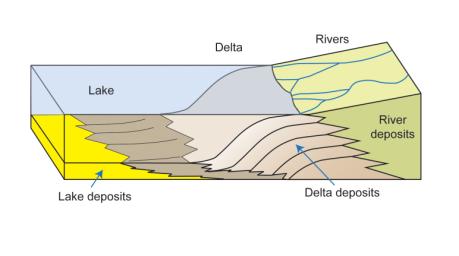
|
How a Delta Forms Where River Meets Lake
- Click the image above for a larger view
- Full-Res JPEG (1931 x 1078) (112.7 kB)
- Full-Res TIFF (1931 x 1078) (6.2 MB)
Caption:
This diagram depicts rivers feeding into a lake. Where the river enters the water body, the water's flow decelerates, sediments drop out, and a delta forms, depositing a prism of sediment that tapers out toward the lake's interior. Progressive build-out of the delta through time leads to formation of sediments that are inclined in the direction toward the lake body.
NASA's Mars Curiosity rover found sedimentary rocks with that characteristic inclined pattern during the rover's approach to Mount Sharp, suggesting that where the mountain stands now was formerly a lake.
Background Info:
NASA's Jet Propulsion Laboratory, a division of the California Institute of Technology, Pasadena, manages the Mars Science Laboratory Project for NASA's Science Mission Directorate, Washington. JPL designed and built the project's Curiosity rover.
More information about Curiosity is online at http://www.nasa.gov/msl and http://mars.jpl.nasa.gov/msl/ .
Cataloging Keywords:
| Name | Value | Additional Values |
|---|---|---|
| Target | Mars | |
| System | ||
| Target Type | Planet | |
| Mission | Mars Science Laboratory (MSL) | |
| Instrument Host | Curiosity Rover | |
| Host Type | Rover | |
| Instrument | ||
| Detector | ||
| Extra Keywords | Color, Mountain, Water | |
| Acquisition Date | ||
| Release Date | 2014-12-08 | |
| Date in Caption | ||
| Image Credit | NASA/JPL-Caltech/Imperial College | |
| Source | photojournal.jpl.nasa.gov/catalog/PIA19071 | |
| Identifier | PIA19071 | |
